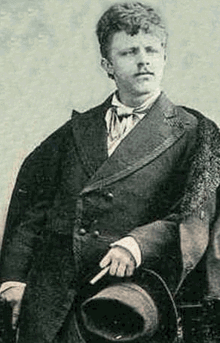Frank Duveneck
| Frank Duveneck | |
|---|---|
 Frank Duveneck in 1874 | |
| Born |
October 9, 1848 Covington, Kentucky |
| Died | January 3, 1919 (aged 70) |
| Nationality | American |
| Field | Painting |
Frank Duveneck (October 9, 1848 – January 3, 1919) was an American figure and portrait painter.
Youth
Duveneck was born in Covington, Kentucky, the son of German immigrant Bernhard Decker. Decker died when Frank was only a year old and his widow remarried Joseph Duveneck. By the age of fifteen Frank had begun the study of art under the tutelage of a local painter, Johann Schmitt, and had been apprenticed to a German firm of church decorators.[1] While having grown up in Covington, Duveneck was a part of the German community in Cincinnati, Ohio, just across the Ohio River. However, due to his Catholic beliefs and German heritage, he was an outsider as far as the artistic community of Cincinnati was concerned.[2] In 1869, he went abroad to study with Wilhelm von Diez and Wilhelm Leibl at the Royal Academy of Munich, where he learned a dark, realistic and direct style of painting. He subsequently became one of the young American painters—others were William Merritt Chase, John Henry Twachtman, Willis Seaver Adams and Walter Shirlaw—who in the 1870s overturned the traditions of the Hudson River School and started a new art movement characterized by a greater freedom of paint application.
Success

His work, at first ignored, when shown in Boston and elsewhere about 1875, attracted great attention, and many pupils flocked to him in Germany and Italy, where he made long visits. Henry James called him "the unsuspected genius" and at the age of 27 he was a celebrated artist. In 1878, Duveneck opened a school in Munich, and in the village of Polling in Bavaria. His students, known as the "Duveneck Boys", included Twachtman, Otto Bacher, Julius Rolshoven, and Herman Wessel.[3]
In 1886, Duveneck married one of his students who was much admired by Henry James, Boston-born Elizabeth Boott. They lived in Bellosguardo for two years where she produced a son, Frank Boott Duveneck. She died later in Paris of pneumonia. Duveneck was devastated. After returning from Italy to America, he gave some attention to sculpture, and modelled a fine monument to his wife, now in the English cemetery in Florence. Despite this activity, Elizabeth's death marked a slowing in his productivity; a wealthy man, he chose to lead a life of relative obscurity. He lived in Covington until his death in 1919 and taught at the Art Academy of Cincinnati, where some pupils of note were John Christen Johansen, M. Jean McLane, Edward Charles Volkert and Russel Wright.
In later years, he often spent summers in Gloucester, Massachusetts.[2]
Among his most famous paintings are Lady with Fan (1873) and The Whistling Boy (1872), both of which reveal Duveneck's debt to the dark palette and slashing brushwork of Frans Hals. His work can be seen at the Metropolitan Museum of Art in New York City, the National Gallery of Art in Washington, DC, the Museum of Fine Arts in Boston, the Cincinnati Art Museum, the Richmond Art Museum,the Kenton County Library in Covington, Ky, and the Cathedral Basilica of the Assumption, also in Covington and the Frances Lehman Loeb Art Center in Poughkeepsie, NY. A portrait, Young Man with Tousled Hair (the Street Urchin), now in the Smithsonian American Art Museum, was previously in the collection of Kurt Vonnegut.[4] In 1905 he was elected into the National Academy of Design as an Associate member, and became a full Academician in 1906.
Duveneck is buried at the Mother of God Cemetery, in Covington.[5]
A life-size bronze statue depicting Duveneck stands in a small park at the intersection of Pike and Washington streets in Covington, Kentucky.
Gallery
-

Elizabeth Boott wearing up-to-date bustled fashions
-

Portrait of Winslow Homer,
-

Major Dillard H. Clark, oil on canvas, 1877. Corcoran Gallery of Art
Bibliography
- Poole, Emily. "The Etchings of Frank Duveneck" The Print Collector’s Quarterly 1938 Oct Vol 25, No. 3, p313.
- Poole, Emily. "Catalogue of the Etchings of Frank Duveneck" The Print Collector’s Quarterly 1938 Dec Vol 25, No. 4, p447.
Notes
- ↑ Mahonri Sharp, Young (1969). "The Two Worlds of Frank Duveneck". American Art Journal (full text) (Kennedy Galleries, Inc.) 1 (1): 92. doi:10.2307/1593857. JSTOR 1593857.
- ↑ 2.0 2.1 Cayton, Andrew R.L. (2002). Ohio: The History of a People. Ohio University Press. pp. 255–257. ISBN 0-8142-0899-1.
- ↑ Biography, Smithsonian Archives of American Art
- ↑ "Art inventories catalog, Smithsonian American Art Museum". Siris-artinventories.si.edu. 1936-06-21. Retrieved 2013-12-03.
- ↑ Federal Writers' Project (1996). The WPA Guide to Kentucky. University Press of Kentucky. p. 155. Retrieved 24 November 2013.
References
- Encyclopedia of Kentucky. New York, New York: Somerset Publishers. 1987. pp. 145–147. ISBN 0-403-09981-1.
- Heermann, Norman (1918). Frank Duveneck. Houghton Mifflin. Retrieved 2008-11-22.
- Attribution
-
 This article incorporates text from a publication now in the public domain: Chisholm, Hugh, ed. (1911). "Duveneck, Frank". Encyclopædia Britannica (11th ed.). Cambridge University Press
This article incorporates text from a publication now in the public domain: Chisholm, Hugh, ed. (1911). "Duveneck, Frank". Encyclopædia Britannica (11th ed.). Cambridge University Press
External links
| Wikimedia Commons has media related to Frank Duveneck. |
- Works by Duveneck at the Cincinnati Art Museum.
- www.artistarchive.com Poole catalogue of 30 prints with a description of each and some images.
- Frank Duveneck at Find a Grave
|